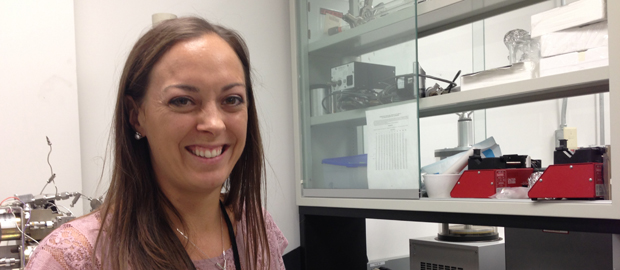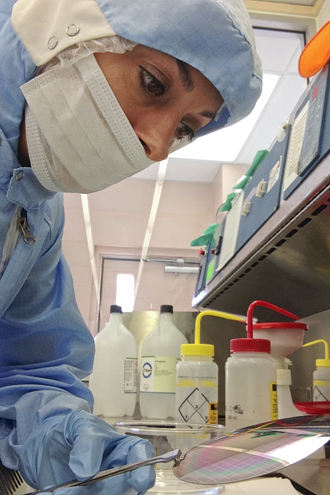Brandeis to NASA: Developing tech to boldly go where no tech has gone before

Venus may be the goddess of love but her celestial eponym is downright nasty.
Temperatures rage upward of 900 degrees Fahrenheit, hot enough to melt lead. High atmospheric pressure crushes asteroids before they can penetrate the planet’s thick clouds of sulfuric acid. The only probes ever to land on Venus’ surface survived about two hours before being destroyed by the elements.
To explore planets with such extreme environments, NASA needs equipment strong enough to survive these harsh conditions, sensitive enough to perform scientific research, and small enough to fit on a spacecraft.
Luckily for NASA, Valerie Scott ’05, is on the case. An inorganic chemist at NASA’s Jet Propulsion Laboratory (JPL), in Pasadena, Calif., Scott designs small technologies for space and planetary exploration. One of her missions is to develop instruments to chemically analyze soil, rock or ice samples on the surface of celestial bodies.
The first step in creating such instruments is designing technology that can withstand the stressors of space travel, including the shock of launch and landing, huge fluctuations in temperature and the merciless environments of foreign worlds.
“Traditional electronics can’t survive an environment like the one on Venus,” Scott says. “So we need to develop technologies that can operate effectively in harsh environments.”
 |
| Scott in the lab |
Scott and her team, which includes physicists, roboticists and engineers, are developing carbon nanotube electronics — cylindrical structures made of carbon molecules — to withstand extreme temperatures.
Another challenge is extracting and analyzing samples because techniques for sample analysis on Earth won't cut it in space.
“On Earth, if you want to extract amino acids from dirt, you boil the sample in hydrochloric acid,” Scott says. “But you can’t easily convince a flight team to take HCl on a spacecraft, so the challenge is finding a new process with materials that are cheap, easy to handle and purify, like water.”
Scott and her colleagues developed a device that breaks down chemical bonds using water heated by radio frequency radiation. The results can then be analyzed in several ways, including using a mass spectrometer similar to one on board the Mars Curiosity Rover.
Scott never imagined one day working for NASA. With a passion for forensics, Scott was more interested in looking six feet under than up to the heavens. But at Brandeis, she fell in love with inorganic chemistry and cut her teeth doing research with former professor Oleg Ozerov.
After Brandeis, Scott earned a PhD in inorganic chemistry at the California Institute of Technology. She started working for the Jet Propulsion Laboratory as a postdoctoral fellow and decided to stay on. “At some schools, the undergraduate researcher is the lowest on the totem pole. They work for a graduate student, who works for a post-doc, who works for the professor. But I worked directly with Professor Ozerov,” Scott says. “It was a great research experience.”
The equipment she and her team design are years, perhaps decades, away from being deployed in outer space but Scott says she doesn’t mind waiting.
“So many technologies developed by NASA end up having commercial applications on Earth. If something I develop can be used on Earth, that would be a big win, too,” Scott says.
But nothing will match the exhilaration of seeing her technologies on the launch pad, she says.
“If or when that happens, it will be incredible.”
Want to know more about searching the cosmos for signs of life? We spoke with Judith Herzfeld, professor of biophysical chemistry, about the tell-tale signs of alien life and her own work with NASA. Check out ReAction: A Brandeis University Science and Research blog for the story.
Categories: Alumni, Research, Science and Technology





